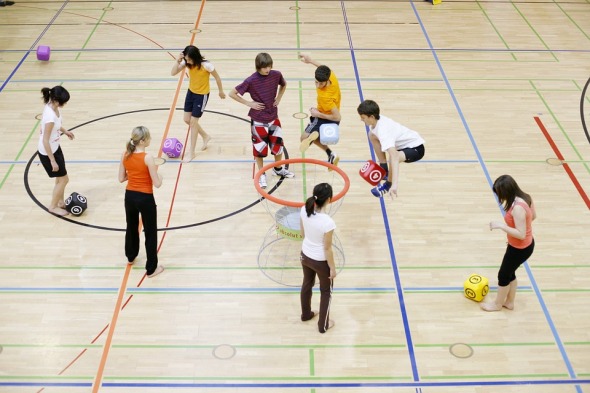The UK has the highest rate of childhood obesity in Europe. A quarter of children are overweight or obese, and research by the government’s Foresight programme suggests that some 40 percent of Britons will be obese by 2025, if current trends continue.
Until recently, school food was part of the problem – deficient in some of the nutrients essential for healthy growth, but high in sugar, salt, and saturated fat.
In 2005, pioneering chef, and intransigent healthy school food advocate, Jamie Oliver, alongside the School Food Plan, helped to galvanise a change in approach that has since revolutionised school food provisions.
Additional funding from the DfE gave schools more scope to invest in better-quality ingredients and to improve kitchen facilities, while new mandatory nutritional standards were introduced across England’s primary and secondary schools.
But, mounting financial pressures on school budgets are putting the brakes on the school food revolution.
The prospect of further cuts has lurked in the background since the government released their election manifesto. The proposals to cut free school meals and replace them with free school breakfasts for all primary school pupils could mark an end to the efforts of the aforementioned.
In August 2016, the government launched its agenda for improving the health of children through their ‘Childhood obesity: a plan for action’. The plan recommends that all children and young people should engage in ‘moderate to vigorous intensity’ physical activity for at least 60 minutes every day.
The strategy also states that Ofsted will use evidence gained from meetings with school leaders, including governors, to assess the impact of additional funding on improving the quality and breadth of PE and sport provision.
Our guidance document, Childhood Obesity: A Plan for Action, summarises the strategy.
So, with the brunt of the obesity epidemic falling on the shoulders of schools, teamed with financial unrest and cuts to funding, how can schools encourage and ensure their pupils are leading a healthy lifestyle?
Reserve the school hall
Reserve the school hall after school, or during a free slot in the day, and put on an easy-to-follow group workout video!
Personal trainer and Instagram celebrity, Joe Wicks, does live high-intensity interval training (HIIT), designed specifically for schools. Getting involved in activities like this works well – Joe Wicks is a well-known fitness guru and is also a popular social media star. Using a celebrity could be a good way to encourage children to partake in this exercise.
Joe’s latest HIIT video for schools, performed on 14 June 2017, can be found here:
Whole-school food approach
Adopting a whole-school food policy is a good way to set out the school community’s intentions towards healthy food in schools.
It acknowledges the impact that the uptake of a healthy diet has on the health and performance of pupils, and further recognises the importance that the understanding of a healthy lifestyle and nutrition has on the wider community.
Governing boards also have a key role to play – in some cases they are legally responsible for ensuring that the school food standards are met. In all schools, governing boards have a duty to ensure that a healthy eating culture is fostered throughout their school and forms part of its ethos.
By using our Whole-School Food Policy template, schools can ensure that they adhere to relevant standards for school lunches and provide pupils with healthy, nutritional and balanced meals when they are at school.
Alongside this, use our School Food Plan Checklist to ensure you are complying with school food regulations.
Involve parents

Parents play a significant role in supporting their children’s health and learning, guiding their children successfully through school processes, and advocating for their children and for the effectiveness of schools.
A few things schools can do to enhance communication with parents about health and education are as follows:
- Use a variety of communication methods, such as flyers, memos, banners, signs, door hangers, newsletters, report cards, postcards, letters, website messages and emails to discuss topics around health.
- Use a variety of verbal or face-to-face communication methods, such as phone calls home, parent-teacher meetings, meetings, school events and regular parent seminars to discuss health topics.
- Translate health-related materials into different languages, or identify health materials already available in languages spoken by parents in the school community. Encouraging parent volunteers to assist with this is a good way of keeping costs down whilst encouraging parental engagement.
- Host a nutrition night for parents, with activities for children. Eating well helps children do better in school – holding an informative seminar for parents on how food choices affect learning is a great way of getting parents on board.
- Ensure the school nurse works with parents to create individualised education, health and care plans for children with special health and medication needs, and special educational needs.
- Encourage parents to serve as mentors, coaching assistants, and tutors for school health activities
- Invite parent volunteers to lead lunchtime walks, weekend games, and after-school exercise programmes.
Parents play a pivotal role in helping to control the obesity epidemic, and during this time of financial unrest in schools, encouraging parents to volunteer is a step to easing the monetary and emotional burden for schools.
Engage with the local community
Creating partnerships with the broader community, e.g. local farms, sporting clubs, and libraries is a good place to start:
- Taking a trip to a local farm or farmer’s market can be a great learning adventure – many farmers are more than happy to share their passion and livelihood with pupils. Learning about sustainable living and organic food is a good way of helping pupils see where their food comes from.
- Encourage local gardeners, or parents, to help plant a vegetable garden within the school – encouraging children to assist and maintain the garden is an effective whole-study approach to the origins of food.
- Enlist a local chef, culinary student, or parent to teach pupils basic cooking skills. Children are more likely to eat healthy foods if the presentation is appetising and if they have a hand in the preparation.
Our Community Engagement Resource Pack contains guidance, policies, and templates to help your school achieve successful community development and engagement.
Encouraging physical activity

Some useful ways in which schools can encourage pupils to become more active include:
- Developing a whole-school physical activity approach, which encourages all staff and pupils to be physically active, then implementing, monitoring and evaluating the policy for impact. Our Secondary PE Policy and Primary PE Policy could be a good place to start!
- Providing a school environment that encourages being active, e.g. adequate playground facilities, access to fitness equipment, suitable walking paths
- Providing secure bike racks or storage to encourage pupils and staff to ride to work
- Scheduling more physical education and physical activity into the curriculum.
- Involving pupils in decisions about the school environment
- Including pupils when deciding on the type of physical activity to be undertaken – this will encourage them to be more committed to participating if they feel they have had a direct impact on the activity to be undertaken
With ever-increasing budget restraints on schools, alongside an amounting pile of responsibilities, such as maintaining the wellbeing and mental health of pupils, it’s no wonder schools are starting to look at alternative ways to incorporate a healthy diet and physical activity in their pupils’ lives.

